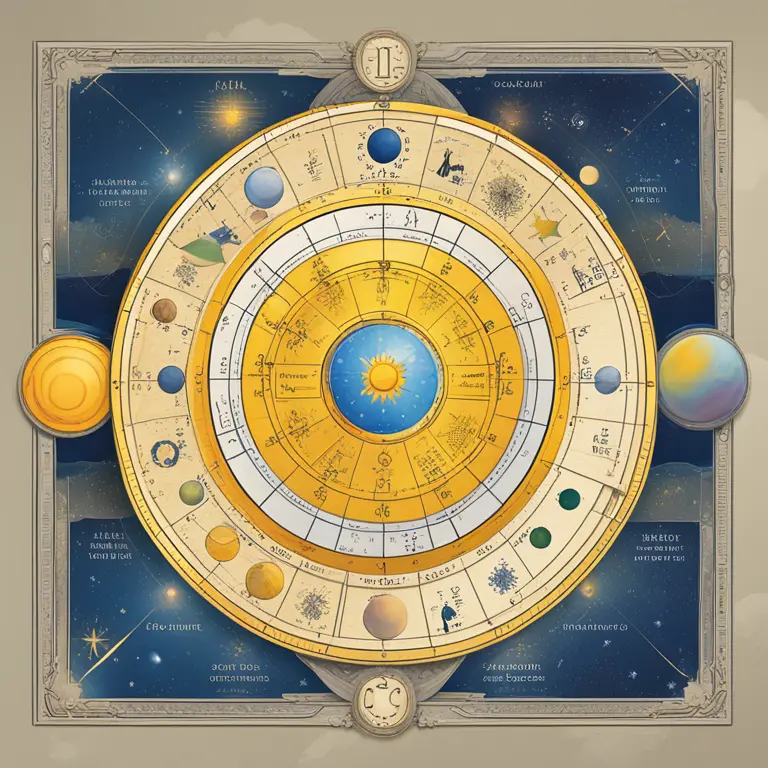
The Stars at Birth: Your Personal Astrology Chart Guide
Discover the insights of astrology birth charts and how the celestial bodies at your birth time shape your life's potential and personality.
article by Priya Deshmukh
Introduction to Birth Charts
Astrology offers a cosmic map of the skies at the very moment you were born — your birth chart. This celestial snapshot captures the position of the sun, moon, and planets, painting a unique astral narrative that many believe influences your personality and life path. A birth chart is not just a starry blueprint of your character but also a guide to personal growth, relationships, and life decisions. Understanding the components of your birth chart can provide valuable insights into your individual disposition, inclinations, and potential challenges.

Components of a Birth Chart
Every birth chart is composed of key astrological elements: planets, signs, houses, aspects, and the Ascendant. Planets symbolize different energies and drives within us, each sign reflects a facet of your personality, and houses represent various life areas where these energies are focused. Aspects describe the angles and relationships between planets, which can either harmonize or create tension. The Ascendant, or rising sign, denotes the mask you present to the world and gives insights into first impressions you make on others.

Significance of Planetary Positions
The sun sign is synonymous with one's core identity, but a birth chart delves much deeper by highlighting moon sign subtleties and planetary influences. Your moon sign governs your emotional inner world, while the placement of Mercury affects communication, Venus governs love and beauty, and Mars drives your energy and aggression. Larger, slower-moving planets like Jupiter and Saturn shape your generational characteristics and major life themes, while outer planets Uranus, Neptune, and Pluto influence societal shifts and personal transformation.

Reading the Houses
The astrological houses in a birth chart unlock the realms of experience. The First House correlates to self-awareness, while the Tenth House connects to career and public image. The Fourth House reveals insights about home and family life, and conversely, the Seventh House pertains to relationships and partnerships. Understanding the houses where planets reside in your birth chart can inform you about where you'll face life's triumphs and tribulations.

Aspects and Their Influence
Aspects in astrology describe the angular distances between planets in your birth chart. They form patterns that can produce harmony, challenge, or a blend of both. For example, trines and sextiles are considered favorable and bring ease to characteristics or life areas involved, whereas squares and oppositions may indicate areas of life where you're likely to experience growth through challenges. Conjunctions, when planets are in close proximity, can amplify or intensify the traits or energies of the involved planets.
Navigating Your Birth Chart in Modern Times
Today, the interpretation of birth charts embraces both traditional practices and the insights of modern psychology. Current astrological readings highlight not just predestined traits, but also the plethora of possibilities that can be brought forth through free will and personal growth. The understanding of astrology evolves with society, reflecting current norms, ideals, and challenges. A birth chart reading can thus serve as a living document, adaptable and relevant to the times.
Personal Empowerment through Astrology
At its heart, an astrology birth chart is a tool for self-empowerment and awareness. While the stars may suggest certain directions, it is ultimately up to the individual to navigate their path in life. Astrology provides a framework for understanding oneself better, enabling individuals to make more informed decisions that resonate with their innate tendencies and potentials.
Published: 2/13/2024
Modified: 2/13/2024
More predictions
Come back here soon to learn more about yourself and your future


Mastering Tarot Basics: A Beginner’s Guide
Embark on a journey into the art of tarot reading with our beginner’s guide, covering fundamental concepts and practical how-to steps.


The Essential Tarot Card Meanings Guide with Images
Discover the meanings behind the mystical tarot cards with our comprehensive guide, complete with vivid imagery to enhance your understanding of each card's symbolism.


The Tarot Queen of Cups: A Sign of Compassion and Insight
Delve into the symbolism and significance of the Queen of Cups in Tarot, uncovering her nurturing essence and intuitive power in divination.